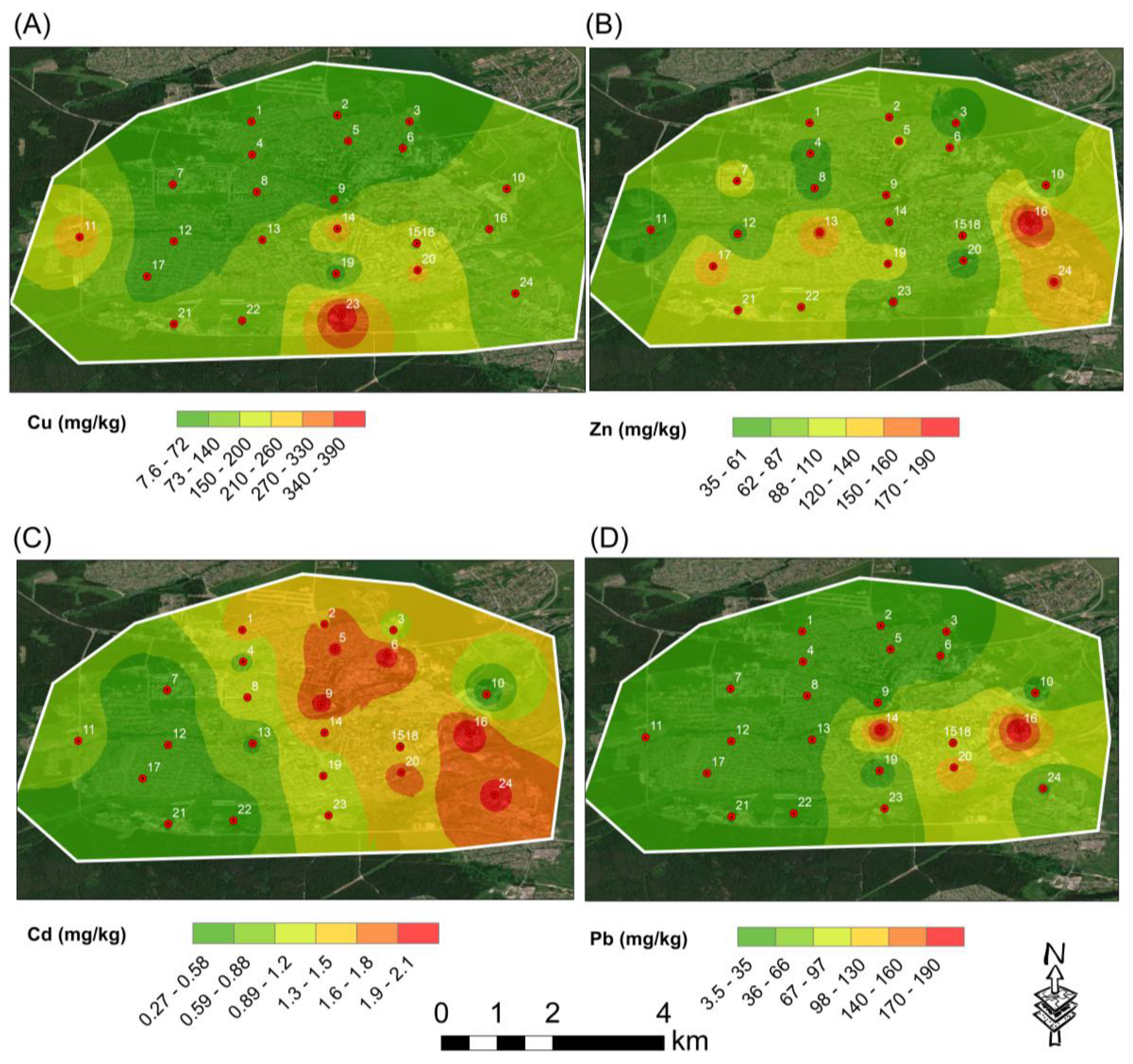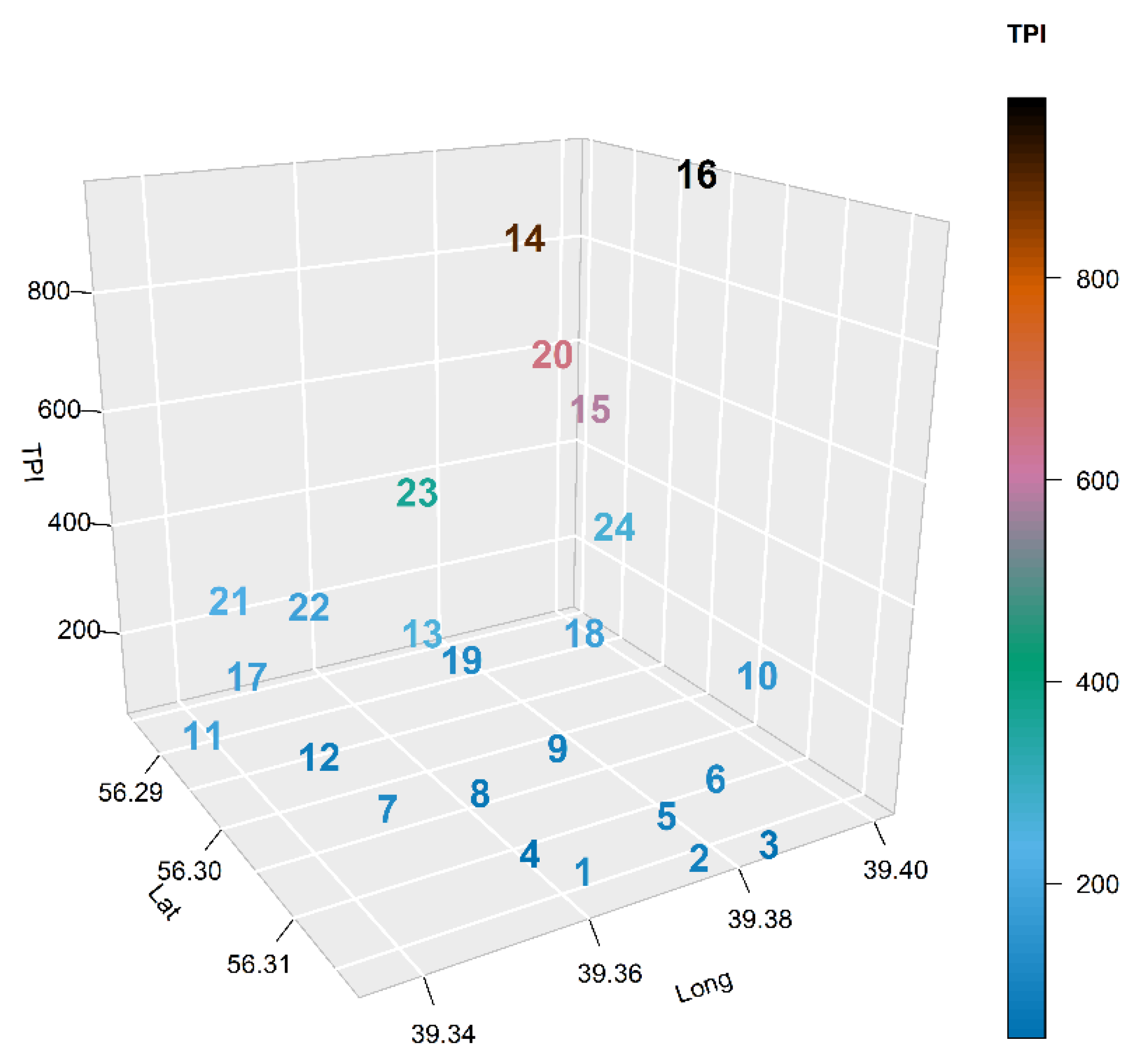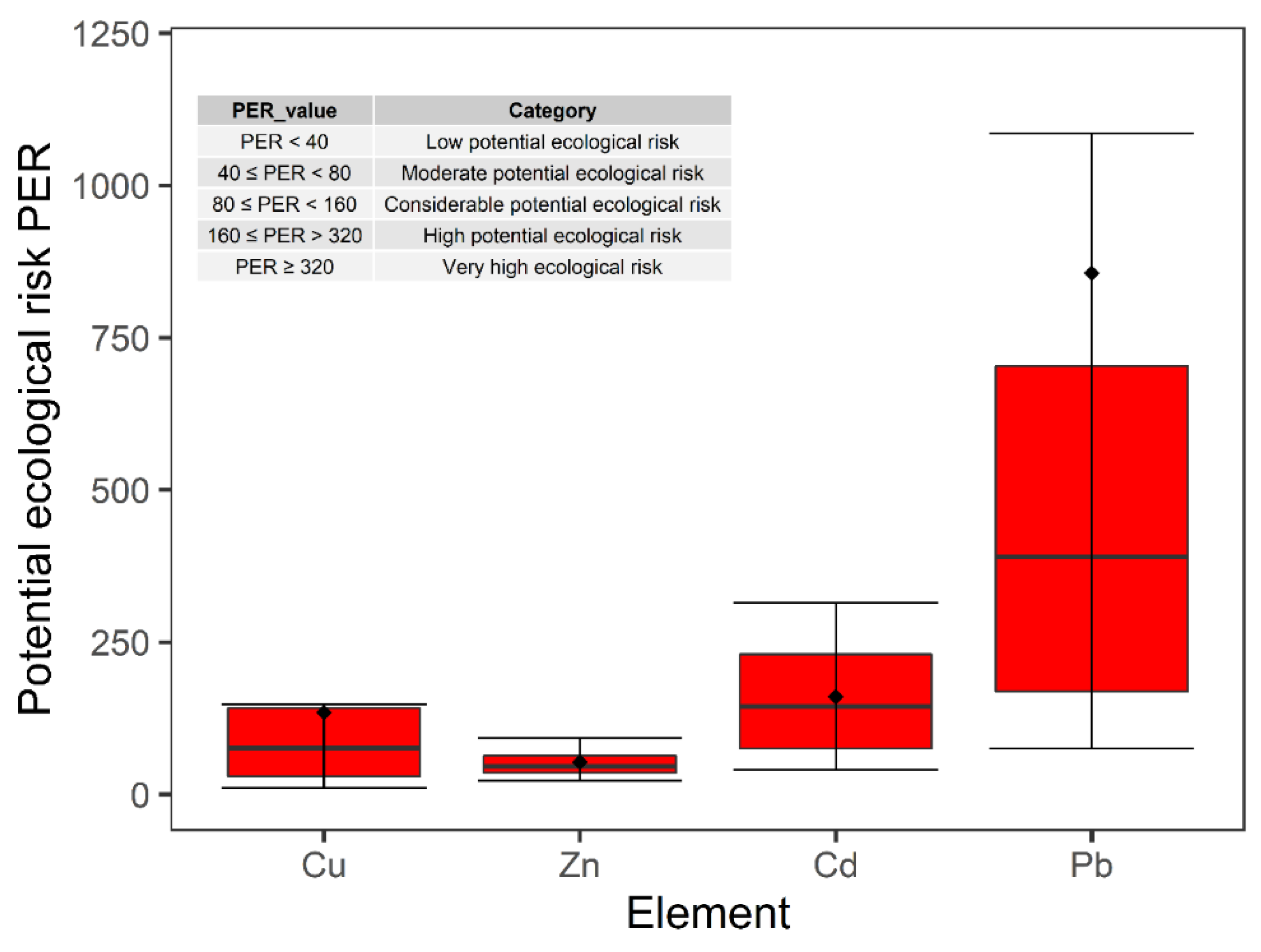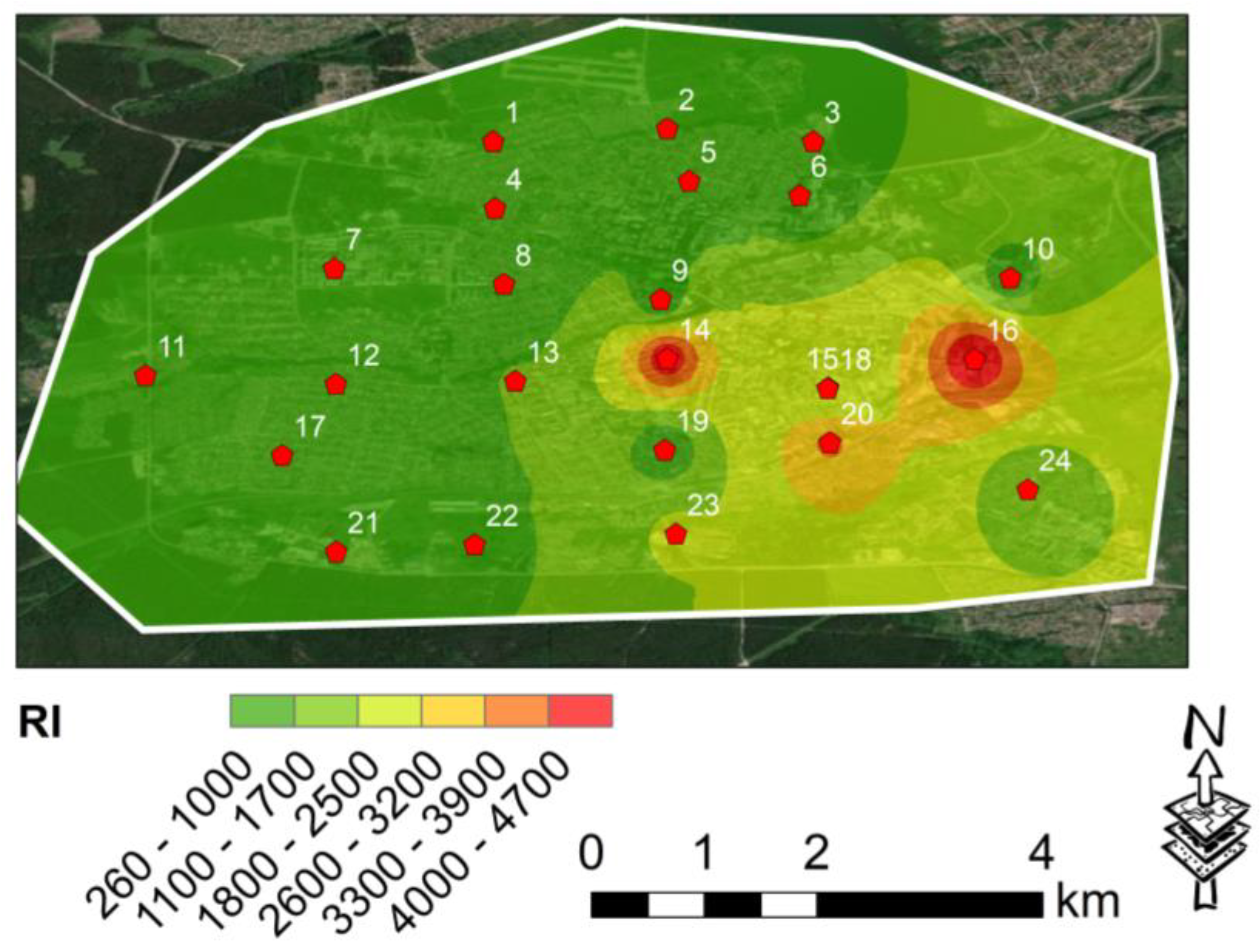Assessment of Soil Potentially Toxic Metal Pollution in Kolchugino Town, Russia: Characteristics and Pollution
Abstract
1. Introduction
2. Materials and Methods
2.1. Sampling Strategy
2.2. Features of the Studied Area
2.3. Sample Preparation for Analysis
2.4. Analytical Method
2.5. Statistical Data Analysis
3. Pollution Extent and Possible Webs
3.1. The Pollution Load Index (PLI)
3.2. Total Pollution Index TPI (Zc)
3.3. Potential Ecological Risk Index (PER)
3.4. Risk Index (RI)
4. Remote Sensing Data and Analysis
5. Results and Discussion
5.1. Elemental Abundances
5.2. Hierarchical Clustering Analysis (HCA)
6. Remarks on the Pollution Extent
7. Observations of Land-Use/Land-Cover (LCLU)
8. Conclusions
Supplementary Materials
Author Contributions
Funding
Data Availability Statement
Conflicts of Interest
References
- El Behairy, R.A.; El Baroudy, A.A.; Ibrahim, M.M.; Mohamed, E.S.; Rebouh, N.Y.; Shokr, M.S. Combination of GIS and Multivariate Analysis to Assess the Soil Heavy Metal Contamination in Some Arid Zones. Agronomy 2022, 12, 2871. [Google Scholar] [CrossRef]
- El-Taher, A.; Badawy, W.M.; Alshahrani, B.; Ibraheem, A.A. Neutron activation and ICP-MS analyses of metals in dust samples-Kingdom of Saudi Arabia: Concentrations, pollution, and exposure. Arab. J. Geosci. 2019, 12, 635. [Google Scholar] [CrossRef]
- Badawy, W.M.; Sarhan, Y.; Duliu, O.G.; Kim, J.; Yushin, N.; Samman, H.E.; Hussein, A.A.; Frontasyeva, M.; Shcheglov, A. Monitoring of air pollutants using plants and co-located soil-Egypt: Characteristics, pollution, and toxicity impact. Environ. Sci. Pollut. Res. Int. 2022, 29, 21049–21066. [Google Scholar] [CrossRef]
- Madadzada, A.I.; Badawy, W.M.; Hajiyeva, S.R.; Veliyeva, Z.T.; Hajiyev, D.B.; Shvetsova, M.S.; Frontasyeva, M.V. Assessment of atmospheric deposition of major and trace elements using neutron activation analysis and GIS technology: Baku-Azerbaijan. Microchem. J. 2019, 147, 605–614. [Google Scholar] [CrossRef]
- Badawy, W.M.; Duliu, O.G.; Frontasyeva, M.V.; El-Samman, H.; Mamikhin, S.V. Dataset of elemental compositions and pollution indices of soil and sediments: Nile River and delta-Egypt. Data Brief 2020, 28, 105009. [Google Scholar] [CrossRef]
- Badawy, W.M.; El-Taher, A.; Frontasyeva, M.V.; Madkour, H.A.; Khater, A.E.M. Assessment of anthropogenic and geogenic impacts on marine sediments along the coastal areas of Egyptian Red Sea. Appl. Radiat. Isot. 2018, 140, 314–326. [Google Scholar] [CrossRef]
- Morton-Bermea, O.; Hernández-Álvarez, E.; González-Hernández, G.; Romero, F.; Lozano, R.; Beramendi-Orosco, L.E. Assessment of heavy metal pollution in urban topsoils from the metropolitan area of Mexico City. J. Geochem. Explor. 2009, 101, 218–224. [Google Scholar] [CrossRef]
- Tong, S.; Li, H.; Wang, L.; Tudi, M.; Yang, L. Concentration, Spatial Distribution, Contamination Degree and Human Health Risk Assessment of Heavy Metals in Urban Soils across China between 2003 and 2019-A Systematic Review. Int. J. Environ. Res. Public Health 2020, 17, 3099. [Google Scholar] [CrossRef]
- Shokr, M.S.; Abdellatif, M.A.; El Behairy, R.A.; Abdelhameed, H.H.; El Baroudy, A.A.; Mohamed, E.S.; Rebouh, N.Y.; Ding, Z.; Abuzaid, A.S. Assessment of Potential Heavy Metal Contamination Hazards Based on GIS and Multivariate Analysis in Some Mediterranean Zones. Agronomy 2022, 12, 3220. [Google Scholar]
- Hammam, A.A.; Mohamed, W.S.; Sayed, S.E.-E.; Kucher, D.E.; Mohamed, E.S. Assessment of Soil Contamination Using GIS and Multi-Variate Analysis: A Case Study in El-Minia Governorate, Egypt. Agronomy 2022, 12, 1197. [Google Scholar] [CrossRef]
- Abuzaid, A.S.; Jahin, H.S.; Shokr, M.S.; El Baroudy, A.A.; Mohamed, E.S.; Rebouh, N.Y.; Bassouny, M.A. A Novel Regional-Scale Assessment of Soil Metal Pollution in Arid Agroecosystems. Agronomy 2023, 13, 161. [Google Scholar] [CrossRef]
- Abdusamadzoda, D.; Abdushukurov, D.A.; Duliu, O.G.; Zinicovscaia, I. Assessment of the Toxic Metals Pollution of Soil and Sediment in Zarafshon Valley, Northwest Tajikistan (Part II). Toxics 2020, 8, 113. [Google Scholar] [CrossRef]
- Abu-hashim, M.; Lilienthal, H.; Schnug, E.; Kucher, D.E.; Mohamed, E.S. Tempo-Spatial Variations in Soil Hydraulic Properties under Long-Term Organic Farming. Land 2022, 11, 1655. [Google Scholar] [CrossRef]
- Abdel-Fattah, M.K.; Mohamed, E.S.; Wagdi, E.M.; Shahin, S.A.; Aldosari, A.A.; Lasaponara, R.; Alnaimy, M.A. Quantitative evaluation of soil quality using Principal Component Analysis: The case study of El-Fayoum depression Egypt. Sustainability 2021, 13, 1824. [Google Scholar] [CrossRef]
- Cai, J.S.; Chen, S.Y.; Yu, G.Q.; Zou, Y.F.; Lu, H.X.; Wei, Y.; Tang, J.X.; Long, B.S.; Tang, X.; Yu, D.M.; et al. Comparations of major and trace elements in soil, water and residents? hair between longevity and non-longevity areas in Bama, China. Int. J. Environ. Health Res. 2021, 31, 581–594. [Google Scholar] [CrossRef]
- Mohamed, E.; Ali, A.; El Shirbeny, M.; Abd El Razek, A.A.; Savin, I.Y. Near infrared spectroscopy techniques for soil contamination assessment in the Nile Delta. Eurasian Soil Sci. 2016, 49, 632–639. [Google Scholar] [CrossRef]
- Li, Y.; Liu, F.; Zhou, X.; Wang, X.; Liu, Q.; Zhu, P.; Zhang, L.; Sun, C. Distribution and Ecological Risk Assessment of Heavy Metals in Sediments in Chinese Collapsed Lakes. Pol. J. Environ. Stud. 2017, 26, 181–188. [Google Scholar] [CrossRef]
- Mohamed, E.S.; Baroudy, A.A.E.; El-beshbeshy, T.; Emam, M.; Belal, A.; Elfadaly, A.; Aldosari, A.A.; Ali, A.M.; Lasaponara, R. Vis-nir spectroscopy and satellite landsat-8 oli data to map soil nutrients in arid conditions: A case study of the northwest coast of egypt. Remote Sens. 2020, 12, 3716. [Google Scholar]
- Bityukova, V.R. Environmental Problems of Small Towns in Russia. In Bulletin of Moscow University Geography; Geography and Ecology; Moscow University: Moscow, Russia, 2007; Volume 1. [Google Scholar]
- IUSS Working Group WRB. World Reference Base for Soil Resources 2014, Update 2015 International Soil Classification System for Naming Soils and Creating Legends for Soil Maps; World Soil Resources Reports No. 106; FAO: Rome, Italy, 2015. [Google Scholar]
- The Information System of the Soil-Geographical Database of Russia. Soil of Russia. Available online: https://soil-db.ru/map?lat=56.1149&lng=39.8941&zoom=9 (accessed on 8 February 2022).
- Reimann, C.; Filzmoser, P. Normal and lognormal data distribution in geochemistry: Death of a myth. Consequences for the statistical treatment of geochemical and environmental data. Environ. Geol. 2000, 39, 1001–1014. [Google Scholar] [CrossRef]
- Shapiro, S.S.; Wilk, M.B. An analysis of variance test for normality (complete samples). Biometrika 1965, 52, 591–611. [Google Scholar] [CrossRef]
- R Core Team R: A Language and Environment for Statistical Computing; R Foundation for Statistical Computing: Vienna, Austria, 2020. Available online: https://www.R-project.org/ (accessed on 8 February 2022).
- Kowalska, J.; Mazurek, R.; Gąsiorek, M.; Setlak, M.; Zaleski, T.; Waroszewski, J. Soil pollution indices conditioned by medieval metallurgical activity—A case study from Krakow (Poland). Environ. Pollut. 2016, 218, 1023–1036. [Google Scholar] [CrossRef]
- Kowalska, J.B.; Mazurek, R.; Gąsiorek, M.; Zaleski, T. Pollution indices as useful tools for the comprehensive evaluation of the degree of soil contamination—A review. Environ. Geochem. Health 2018, 40, 2395–2420. [Google Scholar] [CrossRef]
- Hakanson, L. An ecological risk index for aquatic pollution control.a sedimentological approach. Water Res. 1980, 14, 975–1001. [Google Scholar] [CrossRef]
- Varol, M. Assessment of heavy metal contamination in sediments of the Tigris River (Turkey) using pollution indices and multivariate statistical techniques. J. Hazard. Mater. 2011, 195, 355–364. [Google Scholar] [CrossRef]
- Li, Y.H.; Schoonmaker, J.E. 9.1—Chemical Composition and Mineralogy of Marine Sediments. In Treatise on Geochemistry, 2nd ed.; Holland, H.D., Turekian, K.K., Eds.; Elsevier: Oxford, UK, 2014; pp. 1–32. [Google Scholar]
- Saet, Y.E.; Revich, B.A.; Yanin, E.P.; Smirnova, R.S.; Basharkevich, I.L.; Onishchenko, T.L.; Pavlova, L.N.; Trefilova, N.Y.; Achkasov, A.I.; Sarkisyan, S.S. Geochemistry of the Environment; NEDRA: Waltham, MA, USA, 1990. [Google Scholar]
- Andreev, D.N.; Dzyuba, E.A. Total soil heavy metal contamination in various biotops at the territory of Vishersky reserve. Gen. Biol. 2016, 64, 5. [Google Scholar]
- Shaykhutdinova, A.N. Assessment of the degree of contamination agricultural soils Kuzbass mobile forms of heavy metals. In Proceedings of the V International Scientific Conference Dedicated to the 85th Anniversary of the Department of Soil Science and Soil Ecology of TSU, Tomosk, Russia, 10 August 2015; p. 5. [Google Scholar]
- Mohamed, E.S.; Ali, A.; El-Shirbeny, M.; Abutaleb, K.; Shaddad, S.M. Mapping soil moisture and their correlation with crop pattern using remotely sensed data in arid region. Egypt. J. Remote Sens. Space Sci. 2020, 23, 347–353. [Google Scholar] [CrossRef]
- Mohamed, E.S.; Abu-hashim, M.; AbdelRahman, M.A.E.; Schütt, B.; Lasaponara, R. Evaluating the Effects of Human Activity over the Last Decades on the Soil Organic Carbon Pool Using Satellite Imagery and GIS Techniques in the Nile Delta Area, Egypt. Sustainability 2019, 11, 2644. [Google Scholar] [CrossRef]
- Abdel-Fattah, M.K.; Abd-Elmabod, S.K.; Aldosari, A.A.; Elrys, A.S.; Mohamed, E.S. Multivariate Analysis for Assessing Irrigation Water Quality: A Case Study of the Bahr Mouise Canal, Eastern Nile Delta. Water 2020, 12, 2537. [Google Scholar]
- Rudnick, R.L.; Gao, S. Composition of the Continental Crust. In Treatise on Geochemistry; Turekian, K.K., Ed.; Elsevier: Oxford, UK, 2014; pp. 1–51. [Google Scholar]
- Vinogradov, A.P. The Geochemistry of Rare and Dispersed Chemical Elements in Soils, 2nd ed.; Consultants Bureau Enterprises: New York, NY, USA, 1959. [Google Scholar]
- Allajbeu, S.; Yushin, N.S.; Qarri, F.; Duliu, O.G.; Lazo, P.; Frontasyeva, M.V. Atmospheric deposition of rare earth elements in Albania studied by the moss biomonitoring technique, neutron activation analysis and GIS technology. Environ. Sci. Pollut. Res. 2016, 23, 14087–14101. [Google Scholar] [CrossRef]
- Hair, J.F.; Sarstedt, M.; Pieper, T.M.; Ringle, C.M. The use of partial least squares structural equation modeling in strategic management research: A review of past practices and recommendations for future applications. Long Range Plan. 2012, 45, 320–340. [Google Scholar] [CrossRef]
- Zhou, X.; Chen, Q.; Liu, C.; Fang, Y. Using moss to assess airborne heavy metal pollution in Taizhou, China. Int. J. Environ. Res. Public Health 2017, 14, 430. [Google Scholar] [CrossRef]
- Chaligava, O.; Shetekauri, S.; Badawy, W.M.; Frontasyeva, M.V.; Zinicovscaia, I.; Shetekauri, T.; Kvlividze, A.; Vergel, K.; Yushin, N. Characterization of Trace Elements in Atmospheric Deposition Studied by Moss Biomonitoring in Georgia. Arch. Environ. Contam. Toxicol. 2021, 80, 350–367. [Google Scholar] [CrossRef]
- Carlson, D.L. Quantitative Methods in Archaeology Using R; University of Cambridge: Cambridge, UK, 2017. [Google Scholar]
- Struyf, A.; Hubert, M.; Rousseeuw, P. Clustering in an Object-Oriented Environment. J. Stat. Softw. 1997, 1, 1–30. [Google Scholar] [CrossRef]
- Kaufman, L.; Rousseeuw, P.J. Agglomerative Nesting (Program AGNES). In Finding Groups in Data; John Wiley & Sons: Hoboken, NJ, USA, 1990; pp. 199–252. [Google Scholar]
- Badawy, W.; Chepurchenko, O.Y.; El Samman, H.; Frontasyeva, M.V. Assessment of Industrial Contamination of Agricultural Soil Adjacent to Sadat City, Egypt. Ecol. Chem. Eng. S-Chem. I Inz. Ekol. S 2016, 23, 297–310. [Google Scholar] [CrossRef]
- Karuppasamy, M.P.; Qurban, M.A.; Krishnakumar, P.K.; Mushir, S.A.; Abuzaid, N. Evaluation of toxic elements As, Cd, Cr, Cu, Ni, Pb and Zn in the surficial sediments of the Red Sea (Saudi Arabia). Mar. Pollut. Bull. 2017, 119, 181–190. [Google Scholar] [CrossRef]










| ID | Lat | Long | Cu | Zn | Cd | Pb |
|---|---|---|---|---|---|---|
| 1 | 56.3166 | 39.3606 | 29.7 ± 1.2 | 71.4 ± 2.4 | 1.3 ± 0.1 | 11.2 ± 0.7 |
| 2 | 56.3176 | 39.3745 | 15.5 ± 1.0 | 69.0 ± 2.2 | 1.5 ± 0.1 | 7.5 ± 1.0 |
| 3 | 56.3166 | 39.3861 | 13.7 ± 1.0 | 40.2 ± 2.2 | 1.0 ± 0.1 | 3.5 ± 0.5 |
| 4 | 56.3112 | 39.3607 | 10.5 ± 0.7 | 48.7 ± 2.2 | 0.8 ± 0.1 | 4.7 ± 1.0 |
| 5 | 56.3134 | 39.3762 | 16.1 ± 0.2 | 89.6 ± 1.7 | 1.8 ± 0.2 | 5.0 ± 0.2 |
| 6 | 56.3123 | 39.3850 | 29.4 ± 0.7 | 69.9 ± 2.7 | 2.0 ± 0.1 | 10.4 ± 0.5 |
| 7 | 56.3064 | 39.3479 | 42.2 ± 1.2 | 94.0 ± 4.2 | 0.3 ± 0.1 | 10.1 ± 0.3 |
| 8 | 56.3052 | 39.3614 | 22.0 ± 0.5 | 45.4 ± 1.5 | 1.1 ± 0.1 | 7.9 ± 0.3 |
| 9 | 56.3040 | 39.3739 | 15.9 ± 0.7 | 79.3 ± 2.0 | 1.9 ± 0.1 | 6.7 ± 0.8 |
| 10 | 56.3057 | 39.4018 | 95 ± 2 | 69.3 ± 2.4 | 0.3 ± 0.1 | 19.0 ± 0.7 |
| 11 | 56.2979 | 39.3328 | 239.3 ± 11.7 | 35.1 ± 12.4 | 0.7 ± 0.1 | 20.6 ± 0.9 |
| 12 | 56.2972 | 39.3480 | 7.6 ± 1.0 | 55 ± 2 | 0.3 ± 0.1 | 10.3 ± 0.7 |
| 13 | 56.2975 | 39.3623 | 82.8 ± 2.7 | 144 ± 3.2 | 0.5 ± 0.1 | 33.1 ± 3.0 |
| 14 | 56.2993 | 39.3745 | 251.2 ± 18 | 73.7 ± 24.3 | 1.2 ± 0.1 | 180.3 ± 12.6 |
| 15 | 56.2969 | 39.3873 | 236.6 ± 7.7 | 55.2 ± 5.0 | 1.0 ± 0.1 | 111.5 ± 5.5 |
| 16 | 56.2992 | 39.3989 | 73.9 ± 1.2 | 190.0 ± 48.5 | 2.1 ± 0.1 | 190.5 ± 8.5 |
| 17 | 56.2916 | 39.3437 | 58.2 ± 1.2 | 131.8 ± 3 | 0.4 ± 0.1 | 16.9 ± 0.5 |
| 18 | 56.2969 | 39.3873 | 38.4 ± 0.5 | 77.7 ± 2.7 | 1.4 ± 0.1 | 26.5 ± 0.7 |
| 19 | 56.2920 | 39.3742 | 45.5 ± 2.0 | 103.0 ± 3.2 | 0.9 ± 0.1 | 7.3 ± 0.5 |
| 20 | 56.2926 | 39.3874 | 222.2 ± 7.4 | 45.5 ± 12.4 | 1.7 ± 0.1 | 128.2 ± 5.7 |
| 21 | 56.2839 | 39.3480 | 79.9 ± 1.0 | 98.4 ± 5.1 | 0.4 ± 0.1 | 30.7 ± 1.0 |
| 22 | 56.2844 | 39.3591 | 85.4 ± 1.9 | 100.7 ± 10.2 | 0.3 ± 0.1 | 21.2 ± 0.7 |
| 23 | 56.2853 | 39.3751 | 391.2 ± 14.1 | 59.4 ± 24.7 | 1.0 ± 0.1 | 50.0 ± 1.7 |
| 24 | 56.2888 | 39.4032 | 100.8 ± 1.2 | 140.3 ± 3.9 | 1.9 ± 0.2 | 32.1 ± 0.7 |
| Element | Mean ± SE | Median ± MAD * | Min–Max | Skewness | Kurtosis | Permissible Value | UCC [36] | Background | [37] | CV% | Statistic | p Value |
|---|---|---|---|---|---|---|---|---|---|---|---|---|
| Cu | 91.8 ± 20.6 | 51.9 ± 53.2 | 7.6–391.2 | 1.43 | 1.11 | 132 | 28 | 3.41 | 20 | 110 | 0.7695 | 0.0001 |
| Zn | 82.8 ± 7.7 | 72.5 ± 33.5 | 35.1–190 | 1.07 | 0.61 | 220 | 67 | 1.56 | 50 | 46 | 0.9009 | 0.0225 |
| Cd | 1.1 ± 0.1 | 1 ± 0.8 | 0.3–2.1 | 0.20 | −1.39 | 2 | 0.09 | 0.20 | 0.5 | 56 | 0.9249 | 0.075 |
| Pb | 39.4 ± 11.2 | 17.9 ± 16.2 | 3.5–190.5 | 1.76 | 1.72 | 130 | 17 | 0.23 | 10 | 139 | 0.6477 | 0.000 |
Disclaimer/Publisher’s Note: The statements, opinions and data contained in all publications are solely those of the individual author(s) and contributor(s) and not of MDPI and/or the editor(s). MDPI and/or the editor(s) disclaim responsibility for any injury to people or property resulting from any ideas, methods, instructions or products referred to in the content. |
© 2023 by the authors. Licensee MDPI, Basel, Switzerland. This article is an open access article distributed under the terms and conditions of the Creative Commons Attribution (CC BY) license (https://creativecommons.org/licenses/by/4.0/).
Share and Cite
Kamanina, I.Z.; Badawy, W.M.; Kaplina, S.P.; Makarov, O.A.; Mamikhin, S.V. Assessment of Soil Potentially Toxic Metal Pollution in Kolchugino Town, Russia: Characteristics and Pollution. Land 2023, 12, 439. https://doi.org/10.3390/land12020439
Kamanina IZ, Badawy WM, Kaplina SP, Makarov OA, Mamikhin SV. Assessment of Soil Potentially Toxic Metal Pollution in Kolchugino Town, Russia: Characteristics and Pollution. Land. 2023; 12(2):439. https://doi.org/10.3390/land12020439
Chicago/Turabian StyleKamanina, Inna Z., Wael M. Badawy, Svetlana P. Kaplina, Oleg A. Makarov, and Sergey V. Mamikhin. 2023. "Assessment of Soil Potentially Toxic Metal Pollution in Kolchugino Town, Russia: Characteristics and Pollution" Land 12, no. 2: 439. https://doi.org/10.3390/land12020439
APA StyleKamanina, I. Z., Badawy, W. M., Kaplina, S. P., Makarov, O. A., & Mamikhin, S. V. (2023). Assessment of Soil Potentially Toxic Metal Pollution in Kolchugino Town, Russia: Characteristics and Pollution. Land, 12(2), 439. https://doi.org/10.3390/land12020439








